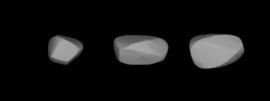Discovered by E. Bowell Discovery date 21 March 1982 Orbits Sun Discoverer Edward L. G. Bowell | Discovery site Anderson Mesa Stn. MPC designation 2709 Sagan Discovered 21 March 1982 | |
 | ||
Alternative names 1982 FH · 1951 WF11959 CC · 1959 EA11964 WT · 1982 FE2 Similar Solar System, Sun, Asteroid belt, 8 Flora | ||
2709 Sagan, provisional designation 1982 FH, is a stony Flora asteroid from the inner regions of the asteroid belt, approximately 6.7 kilometers in diameter. It was discovered by American astronomer Edward Bowell at Lowell's Anderson Mesa Station in Flagstaff, Arizona, on 21 March 1982.
The S-type asteroid is a member of the Flora family, one of the largest groups of stony asteroids in the main-belt. It orbits the Sun at a distance of 2.0–2.3 AU once every 3 years and 3 months (1,188 days). Its orbit has an eccentricity of 0.07 and an inclination of 3° with respect to the ecliptic.
It has an albedo of 0.26, according to observations made by the Wide-field Infrared Survey Explorer and subsequent NEOWISE mission. The body rotates every 5.26 hours once around its axis.
The minor planet was named in honor of Carl Sagan (1934–1996), planetary scientist at Cornell University, science popularizer, editor of the journal Icarus, and founder of The Planetary Society. Sagan participated on a number of planetary space missions, including the Voyager mission to the outer planets and the Mariner 9 and Viking missions to Mars. His research encompassed studies of the greenhouse effect on Venus, the atmosphere and surface of titan, windblown dust on Mars, and the possibility of extraterrestrial intelligent life. Sagan won the Pulitzer prize for literature in 1978. Naming citation was published on 4 August 1982 (M.P.C. 7158).
